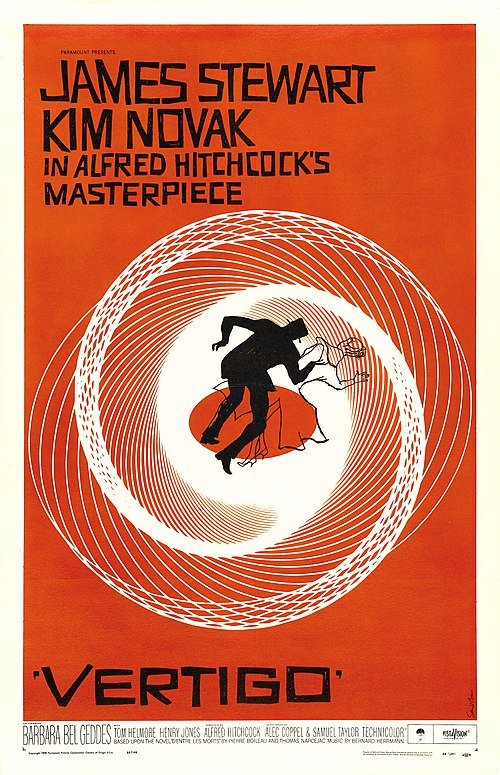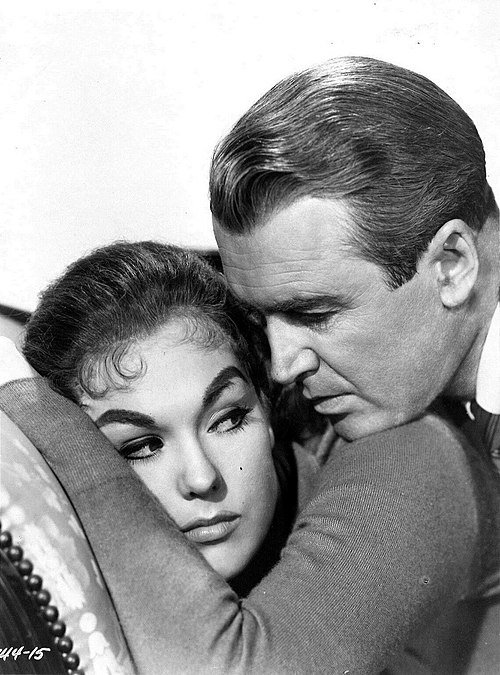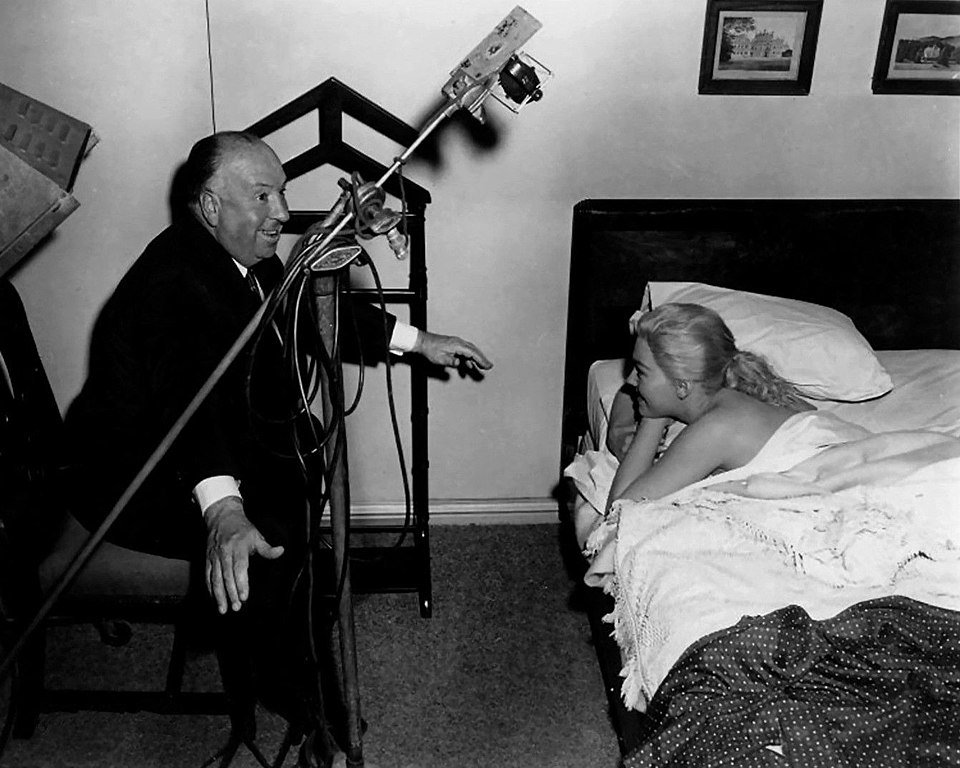
Vertigo
USA, 1958
Director: Alfred Hitchcock
Screenwriter: Arthur Laurents (adaptation of the play by Patrick Hamilton), with the collaboration of Hume Cronyn
Genre: Psychological thriller, suspense
Soundtrack composer: Leo Forbstein
Editor: William H. Ziegler
Production company: Alfred Hitchcock, Sidney Bernstein (Transatlantic Pictures)
Cast:
James Stewart (Rupert Cadell)
John Dall (Brandon Shaw)
Farley Granger (Phillip Morgan)
Joan Chandler (Janet Walker)
Cedric Hardwicke (Henry Kentley)
Constance Collier (Anita Atwater)
Douglas Dick (Kenneth Lawrence)
Edith Evanson (Wilson)
Dick Hogan (David Kentley)
Plot
John “Scottie” Ferguson, a mature, single, lonely man, is a retired police officer who is terrified of heights. After the accidental death of one of his colleagues, who plunged from the roof of a building while they were chasing a criminal, his pathological vertigo has increased to traumatic levels. Even climbing onto a stool already makes him dizzy. Scottie is forced to take sick leave, and feels guilty about the tragic accident, thinking he could have prevented it if he had reacted in time…
Seamstress (lingerie designer) and artist Midge Wood is among his few close friends. The two had a brief romantic relationship in the past. One day, the ex-cop is contacted by an old friend from his youth, Gavin Elster, who wants to commission him for a job as a detective. Gavin is concerned about the strange behavior of his wife Madeleine, and asks Scottie to keep an eye on her, following her discreetly. The woman frequently disappears around town, when she returns she does not remember where she has been, she is listless, melancholy and absent, sometimes falling into trance-like states. Gavin is convinced that Madeleine is being parasitized by an evil spectral force. The detective, more rational and pragmatic, does not believe in such “fables” and thinks rather that he should see a psychiatrist.
At first Scottie is reluctant to undertake the task, reluctantly agreeing and only to do his friend a favor. But soon the job begins to obsess him. He begins to follow the beautiful Madeleine by car all over San Francisco. She buys flowers, goes to a cemetery and lays them at the grave of a certain Carlota Valdes. Then she goes to a museum, sits before the oil portrait of a lady and stares at the painting for hours. Scottie finds out that the woman in the painting is named… Carlota Valdés.
He later follows her to a hotel. The lady at the reception informs the policeman that the young woman is a regular customer of the establishment, usually coming two or three times a week. When the officer asks for the name under which she is registered, the answer does not surprise him too much: “Carlota Valdés”.
With the help of his friend Midge and a French bookseller she knows, the detective discovers that this Carlota was a Spanish woman who lived in San Francisco in the previous century and who went mad and ended up committing suicide in her youth.
After further inquiries, and after speaking with Gavin, it also comes to light that Carlota was a great-grandmother of Madeleine. Everything indicates that little by little the spirit of Carlota is taking possession of her great-granddaughter. Scottie thinks it must be a case of suggestion, that Madeleine is under the influence of the stories told in the family. But Gavin assures her that his wife has never heard of her great-grandmother; the link between the two is instinctive, it is in the blood and at the same time it comes from the “Beyond”.
On another day, after leaving the museum, Scottie follows Madeleine into San Francisco Bay. There he watches in terror as the woman dives into the water. But the detective dives in after her and manages to rescue her. He takes her home, and when Madeleine comes to, she remembers nothing. She also doesn’t remember being in the museum, and in fact claims never to have been inside.
Gavin calls on the phone and Scottie succinctly fills him in on what just happened. “Madeleine is now 26 years old. Carlota committed suicide at 26…” says Gavin in anguish. As the two talk, Madeleine leaves Scottie’s house without saying goodbye.
But she returns the next day to thank him. Scottie and Madeleine go together to a redwood grove outside of town, and a mutual attraction begins to grow between them. She confesses to him that she often has visions of death. She seems to sense that she is fated to die soon, and is plagued by virulent suicidal impulses. He vows to protect her and to always be by her side. The two fall in love and end up kissing passionately.

Meanwhile, Midge is slightly jealous of Scottie’s long absences. To try to get his attention again, she paints an oil portrait of herself as Charlotte. But this has the opposite effect, for when the detective sees the painting he leaves in disgust.
Early the next morning, Madeleine comes to Scottie’s house after having a nightmare. Describing the building where she was during the dream, the detective recognizes it: it is an old Spanish convent (the “Mission San Juan Bautista”) on the outskirts of San Francisco. The two head there. Scottie seeks to employ rational therapeutic methods to cure her, confronting her directly with her fears.
Once there, however, she insists on entering the church alone. By the time Scottie understands why, it is too late: Madeleine climbs the tall bell tower with the intention of throwing herself off. To save her, the detective’s vertigo will once again be a tough obstacle…

Comment
One of my favorite films of the master Hitchcock, this masterpiece of suspense perfectly combines the classic detective intrigue with a romance from beyond the grave, an enormous psychological depth and well dosed supernatural elements.
When he tries to rescue Madeleine, vertigo once again plays a trick on the protagonist. Once again he feels guilty of a tragedy and falls into a deep depression. Scottie has to be hospitalized for months in a clinic. When he gets out, he returns to the same places where he followed Madeleine, hoping to find her there: the cemetery, the museum, the hotel… The deranged detective is still in love beyond death. He notices all the women who bear some physical resemblance to Madeleine. One of these, who has a particular resemblance, he follows her to the hotel where she lives, knocks on her door and wants to meet her. Judy is at first suspicious, and knows that Scottie is interested in her because she reminds him of another. However, she soon gives in and agrees to go out with him.
It would be a great mistake to reveal more plot details, especially in a thriller like this one. “Vertigo” is a film about which you should read as little as possible if you have not yet seen it. From the entrance on the scene of Judy, of such uncanny resemblance to Madeleine that one wonders if it might not be her, the story takes an unsuspected turn. From here on we move away from the supernatural, though not from the mystery or the enigmatic ancestor: something that was Carlota’s property will be a key clue to shed light on the matter….
“Madeleine” is an illusion, a being as ethereal and unattainable as Carlota; an idealized woman on whom Scottie (magnetically attracted to her) projects a love of a self-destructive nature. Manipulation (the control of the mind and senses) is one of the central themes of the film.
Although at the time “Vertigo” went relatively unnoticed on the big screen, over the years it has become a classic, an indisputable example of the good work behind the cameras of the master of suspense. The film is based on a 1954 French mystery novel: Sueurs Froides: D’Entre les Morts (“Cold Sweats: From Among the Dead”), by Boileau-Narcejac.
James Stewart, a regular Hitchcock collaborator, plays the tormented, lovesick detective with a phobia of heights. The beautiful Kim Novak, who radiates a potent erotic aura, brings both Madeleine and Judy to life.
“Vertigo” is powerfully symbolic, with veiled references to the sexual problems afflicting the title character.
Martin Scorsese, the director of “Goodfellas” (1990) and “Casino” (1995) is a great admirer of Hitchcock and particularly of the excellent film in question: “Vertigo is very important to me because it has a protagonist who is completely driven by an obsession”. The memorable credits of “Vertigo” were made by Saul Bass, whom almost four decades later Scorsese hired to design the credits of “Casino”, his gangster epos set in Las Vegas.
Get Vertigo HERE!
(This is an affiliate link. I may earn a commission if you purchase through these link, at no extra cost to you. As an Amazon Associate, I earn from qualifying purchases.)
